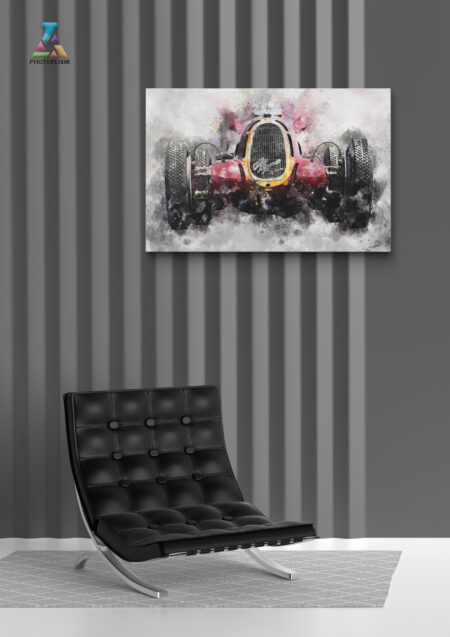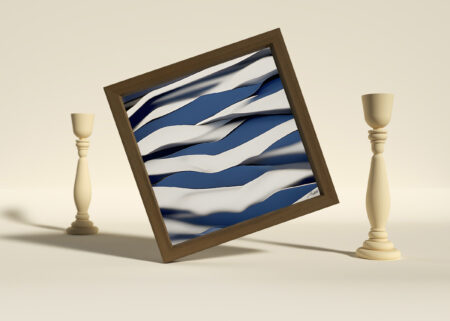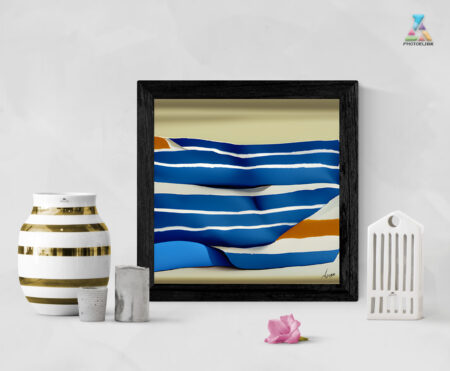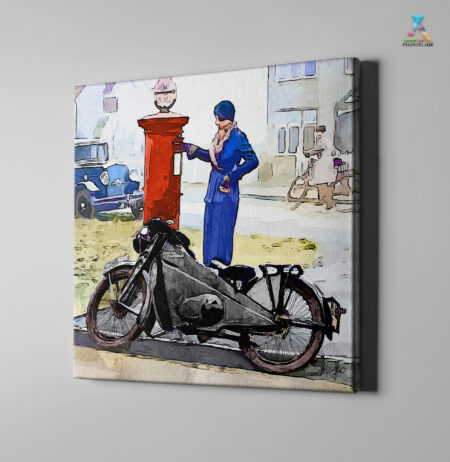Radial Realism by Nizako Art On Canvas 24″×36″
€125.00
As I stand before the stunning artwork titled ‘Radial Realism,’ I am struck by the vibrant and dynamic composition that speaks to the viewer in a language of geometrical shapes and abstract forms.
This painting is a masterpiece of geometric abstraction that mesmerizes with its striking beauty and mesmerizing intricacy.
The painting features a combination of rectangular shapes, a triangle attached to a cube in the middle, and two lines on the upper right side painted in vivid pastel color hues of white, yellow, purple, orange, and blue, on a black background. The color scheme is both playful and harmonious, adding to the artwork’s overall sense of balance and harmony.
The artist behind ‘Radial Realism’ has created a breathtakingly beautiful composition that invites interpretation from the viewer. The geometric shapes are arranged in such a way as to create a sense of movement and dynamism, making the painting seem almost alive with energy.
Geometric abstraction, as an art movement, originated in the early 20th century and is characterized by its use of simple geometric forms to create complex and visually engaging compositions. The movement was part of a larger trend towards abstract art, which rejected traditional representational art in favor of a more experimental and expressive approach.

by Nizako
The title of this painting, ‘Radial Realism,’ is particularly apt, as it captures the essence of both the geometric abstraction movement and the artwork itself.
The term ‘radial’ refers to the arrangement of the shapes in a circular or radiating pattern, while ‘realism’ speaks to the artist’s ability to create a sense of depth and dimensionality within the two-dimensional plane of the canvas.
The use of geometric shapes in ‘Radial Realism’ is a hallmark of the geometric abstraction style. The shapes themselves are simple and unadorned, but the artist has arranged them in such a way as to create a sense of complexity and depth. This use of shape and form to create a visually engaging composition is a defining characteristic of the geometric abstraction movement.
The lines on the upper right side of the painting add an extra layer of complexity to the composition. These lines, painted in vivid pastel hues, create a sense of movement and directionality that draws the viewer’s eye towards the center of the painting. They also provide a sense of contrast to the more static shapes that surround them, creating a sense of balance and harmony within the painting.
The use of color in ‘Radial Realism’ is equally important to the overall effect of the painting. The vivid pastel hues of white, yellow, purple, orange, and blue create a sense of playfulness and whimsy, while the black background provides a sense of contrast and depth. The color scheme is both harmonious and dynamic, adding to the overall sense of movement and energy within the artwork.
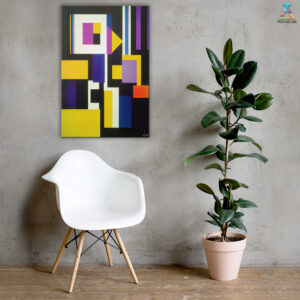
by Nizako
One of the most striking aspects of ‘Radial Realism’ is its ability to evoke different emotions and interpretations from the viewer.
Depending on one’s perspective, the painting can be seen as a representation of order and symmetry, or as a celebration of chaos and spontaneity. The painting’s abstract nature allows the viewer to bring their own experiences and emotions to the interpretation of the artwork.
Overall, ‘Radial Realism’ is a stunning example of the geometric abstraction style. The artwork is both visually engaging and intellectually stimulating, challenging the viewer to explore the relationship between shape, color, and composition. The use of simple geometric forms to create a complex and dynamic composition is a hallmark of the geometric abstraction movement, and this painting is a shining example of the movement’s enduring legacy.
The pastel colors of ‘Radial Realism’ are both soothing and electrifying. The shades of yellow and orange offer a sense of warmth and energy, while the purple and blue hues create a sense of calm and tranquility. The overall effect is a sense of balance and harmony that speaks to the viewer on a visceral level.
The use of the triangle attached to a cube in the center of the painting is particularly interesting. This shape, often associated with stability and order, is juxtaposed with the more fluid and dynamic shapes that radiate outwards from it. This creates a sense of tension and energy that draws the viewer’s eye towards the center of the painting, while also inviting exploration of the shapes and forms that surround it.
In conclusion, ‘Radial Realism’ is a masterpiece of geometric abstraction that speaks to the viewer in a language of shape, color, and composition. The artwork is both visually engaging and intellectually stimulating, inviting interpretation and exploration from the viewer. The use of simple geometric forms to create a complex and dynamic composition is a hallmark of the geometric abstraction movement, and this painting is a shining example of the movement’s enduring legacy. The artist behind ‘Radial Realism’ has created a stunning work of art that will continue to captivate and inspire viewers for generations to come.
Looking to add a little artistic flair to your home or office? Look no further – this beautiful artwork on high-quality canvas has a vivid, fade-resistant print that you’re bound to fall in love with.
Created by Nizako exclusively for Photoelixir.com
Canvas Characteristics:
• Acid-free, PH-neutral, poly-cotton base
• 20.5 mil (0.5 mm) thick poly-cotton blend canvas
• Canvas fabric weight: 13.9 oz/yd2(470 g/m²)
• Fade-resistant
• Hand-stretched over solid wood stretcher bars
• Matte finish coating
• 1.5″ (3.81 cm) deep
• Mounting brackets included
• Blank product in the EU sourced from Latvia
• Blank product in the US sourced from the US
| Weight | 1.45 lbs |
|---|
Size Chart
Size guide| 24″×36″ | |
| Height (inches) | 24 |
| Width (inches) | 36 |
| 24″×36″ | |
| Height (cm) | 61 |
| Width (cm) | 91.4 |







